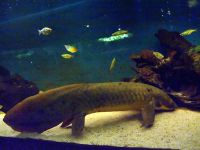Difference between revisions of "Neoceratodus forsteri"
From The Aquarium Wiki
m |
|||
| Line 36: | Line 36: | ||
|max_water_hardness=10 | |max_water_hardness=10 | ||
}} | }} | ||
| − | + | ||
| − | + | == Origin == | |
| − | + | :Oceania: southern Queensland, Australia in Burnett and Mary River systems. Introduced successfully in southeastern Queensland. | |
| − | + | ||
| − | + | ||
| − | + | == Sexing == | |
| − | + | :It is very difficult to visually sex these fish. | |
| − | + | ||
| − | + | ||
| + | == Tank compatibility == | ||
| + | :These are very large unpredictable fish best kept alone in a species tank. They are capable of eating smaller fish and biting chunks out of larger fish, including others of their own species. | ||
| + | |||
| + | |||
| + | == Diet == | ||
| + | :A primarily carnivorous fish best fed on prawn, shrimp, mussels, lancefish and will also accept algae wafers and other vegetable matter. | ||
| + | |||
| + | |||
| + | == Feeding regime == | ||
| + | :Feed once a day. | ||
| + | |||
| + | |||
| + | == Environment specifics == | ||
| + | :Must have a spacious tank, long (min. {{cm|200}}) and wide (min. {{cm|100}}) is more important than depth. It should be well filtered but not have too much current. They are unfussy with décor as long as there's somewhere to hide such as amongst [[bogwood]]. All décor must be very securely in place to stop the fish knocking anything around. They do not appreciate very bright lights. It must be able to access the surface to breath air, but does not require it to breath. Lids must be heavy and secure to prevent escapes. | ||
| + | |||
| + | |||
| + | == Behaviour == | ||
| + | :A large fish known to be unpredictable, capable of biting fish larger than itself causing substantial injuries. | ||
| + | |||
| + | |||
| + | == Identification == | ||
| + | :A large prehistoric fish which, as the name suggests, has the ability of breathing air from the surface through an adapted lung (the Queensland has only one lung, whereas other Lungfish have two) as well as their gills, and even the ability to move over land from pond to pond in the wild. | ||
:Their body is elongated and heavy with deep olive-brown colouration and large scales, the belly is pale. The head is broad with a large mouth and the pectoral and anal fins are adapted to enable the fish to "walk" over land. The dorsal fin is absent. The caudal is large, powerful and primitive-looking. It almost looks amphibian. | :Their body is elongated and heavy with deep olive-brown colouration and large scales, the belly is pale. The head is broad with a large mouth and the pectoral and anal fins are adapted to enable the fish to "walk" over land. The dorsal fin is absent. The caudal is large, powerful and primitive-looking. It almost looks amphibian. | ||
| − | + | ||
| + | |||
{{Categories | {{Categories | ||
|Category=Fish, Fish (Freshwater), Oddballs, Monster Fish | |Category=Fish, Fish (Freshwater), Oddballs, Monster Fish | ||
Latest revision as of 02:24, 13 December 2017
Australian Lungfish
Neoceratodus forsteri
568 Litres (150 US G.)
100-170 cm (39.4-66.9")
Freshwater
6.5 - 7.5
22 -28 °C (71.6-82.4°F)
6-10 °d
1:1 M:F
50-100 years
Family
Ceratodontidae
Contents
Additional names
- Queensland Lungfish, Burnett River Salmon, Barramunda, Ceratodus, Cerat
Additional scientific names
- Ceratodus forsteri, Ceratodus miolepis
Origin[edit]
- Oceania: southern Queensland, Australia in Burnett and Mary River systems. Introduced successfully in southeastern Queensland.
Sexing[edit]
- It is very difficult to visually sex these fish.
Tank compatibility[edit]
- These are very large unpredictable fish best kept alone in a species tank. They are capable of eating smaller fish and biting chunks out of larger fish, including others of their own species.
Diet[edit]
- A primarily carnivorous fish best fed on prawn, shrimp, mussels, lancefish and will also accept algae wafers and other vegetable matter.
Feeding regime[edit]
- Feed once a day.
Environment specifics[edit]
- Must have a spacious tank, long (min. 200cm (78.7")) and wide (min. 100cm (39.4")) is more important than depth. It should be well filtered but not have too much current. They are unfussy with décor as long as there's somewhere to hide such as amongst bogwood. All décor must be very securely in place to stop the fish knocking anything around. They do not appreciate very bright lights. It must be able to access the surface to breath air, but does not require it to breath. Lids must be heavy and secure to prevent escapes.
Behaviour[edit]
- A large fish known to be unpredictable, capable of biting fish larger than itself causing substantial injuries.
Identification[edit]
- A large prehistoric fish which, as the name suggests, has the ability of breathing air from the surface through an adapted lung (the Queensland has only one lung, whereas other Lungfish have two) as well as their gills, and even the ability to move over land from pond to pond in the wild.
- Their body is elongated and heavy with deep olive-brown colouration and large scales, the belly is pale. The head is broad with a large mouth and the pectoral and anal fins are adapted to enable the fish to "walk" over land. The dorsal fin is absent. The caudal is large, powerful and primitive-looking. It almost looks amphibian.
Pictures[edit]
External links[edit]
- Fishbase (Mirrors:
 )
)


